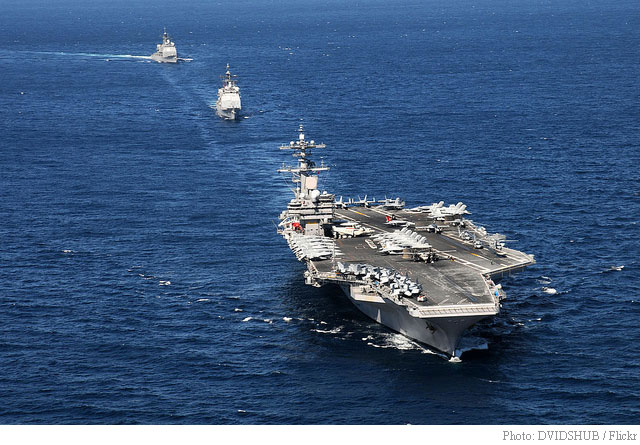In response to the crisis in Crimea, the U.S. has undertaken a number of military moves around the region. While Washington’s military deployments are still far from a direct involvement in the conflict in Ukraine, they do raise the stakes, as the U,S, tries to walk a narrow line, reassuring its allies in the region while avoiding provoking Russia into widening the conflict.
In recent days the U.S. has sent 12 F-16 fighter jets to Poland and Lithuania for joint exercises. NATO has started reconnaissance flights over Poland and Romania, NATO members that border Ukraine. “What we are doing is reassuring our allies that we are there for them,” said U.S. Army Colonel Steve Warren, a Pentagon spokesman, explaining the F-16 deployment. “This is an important time for us to make it crystal clear to all our allies and partners in the region that the United States of America stands by them.”
Nevertheless, as aviation analyst David Cenciotti noted on his blog, the reconnaissance planes NATO has sent are intended for monitoring air activity, and that has been a relatively minor element of the conflict thus far. “The news would have been much more relevant if platform specialized in mapping ground targets (as the E-8C Joint Stars or the RAF Sentinel R1) were involved in the operation: so far Moscow has mainly employed ultra-low-level flying helicopters that could be difficult to detect even for an E-3 at that distance,” he wrote.
On the naval front, the U.S. has sent the aircraft carrier USS George H.W. Bush to the southern coast of Turkey. That’s still 500 miles from Crimea, but it’s within range of the Hornet and Super Hornet strike fighters on board (and aircraft carriers aren’t allowed in the Black Sea, anyway, so this is about as close as the ship could get). And a smaller U.S. warship, the USS Truxtun, is in the Black Sea to conduct joint exercises with counterparts from Bulgaria and Romania. While those exercises were planned in advance, regional analyst Michael Cecire told The Bug Pit that they nevertheless were intended to send a signal to Russia: “Washington is typically pretty sensitive to how a deployment will be perceived and is always willing to postpone, redirect, or cancel an exercise if they worry about the message being sent. In this case, leadership decided to go ahead with transiting a guided missile destroyed into the Black Sea during a time of high tensions,” Cecire said. “For those who are trying to stand against Putin this warship presents the very essence of US commitment (real or perceived) to their cause. Thus the significance of USS Truxtun in the Black Sea is not military but political and diplomatic,” said Cem Devrim Yaylalı, a Turkish naval analyst, in an email interview with The Bug Pit.
The U.S.’s moves are meant to reassure allies near Ukraine, said Robert Farley, a military analyst and political science professor at the University of Kentucky, in an email interview with The Bug Pit:
The movements by the US have little to do with Russia, and a lot to do with reassuring US allies in the region. Even though it doesn’t seem as if the Turks are too worried about events right now, the Poles and the Baltics are all watching the deployments, both in the Baltic and in the Mediterranean. I think it’s also intended to send a message of support to Kiev, although obviously that also needs to be tempered with restraint. And while it does seem to the rational observer (me) that the Russians are unlikely to move against the Poles or the Baltics, I don’t think that they think about the situation in the same way. And so really, it’s about alliance maintenance.
While the U.S. and NATO may not get directly involved in Ukraine, if the situation there gets worse it could quickly spread to NATO member countries, Raymond Pritchett, an American military analyst, told The Bug Pit: “What happens if Ukraine tries to take back Crimea with force and Russia launches a full invasion of South and Southeastern Ukraine? Poland could have over 1 million refugees before April 1st under that scenario. In two years Turkey only has 900,000 Syrian refugees,” he said.
But this also is a classic security dilemma, in which the U.S. and NATO’s attempts to make its allies feel more secure can also make Russia feel threatened. There have been reports that, in response to the U.S. naval moves, Russia has moved anti-ship missiles into Crimea. And Dmitry Rogozin, Russia’s deputy prime minister in charge of the defense industry, has said that the U.S. and NATO moves amount to “threats” that justify Russia’s military modernization. “I hope that after the overt threats by the U.S. and NATO nobody will doubt the necessity of rearming our army and fleet and of reviving our defense industry and military science,” he said. Nevertheless, the Kremlin’s response thus far to these various moves has been relatively muted, at least in public. We’ll see how long that lasts.
“Originally published by EurasiaNet.org“
- Bulenox: Get 45% to 91% OFF ... Use Discount Code: UNO
- Risk Our Money Not Yours | Get 50% to 90% OFF ... Use Discount Code: MMBVBKSM
Disclaimer: This page contains affiliate links. If you choose to make a purchase after clicking a link, we may receive a commission at no additional cost to you. Thank you for your support!




Leave a Reply